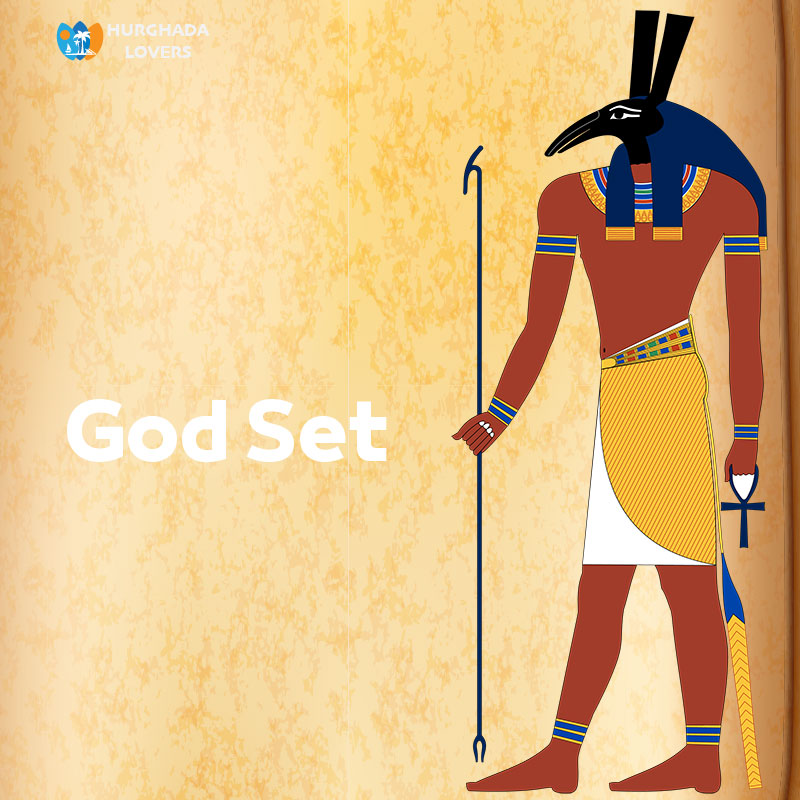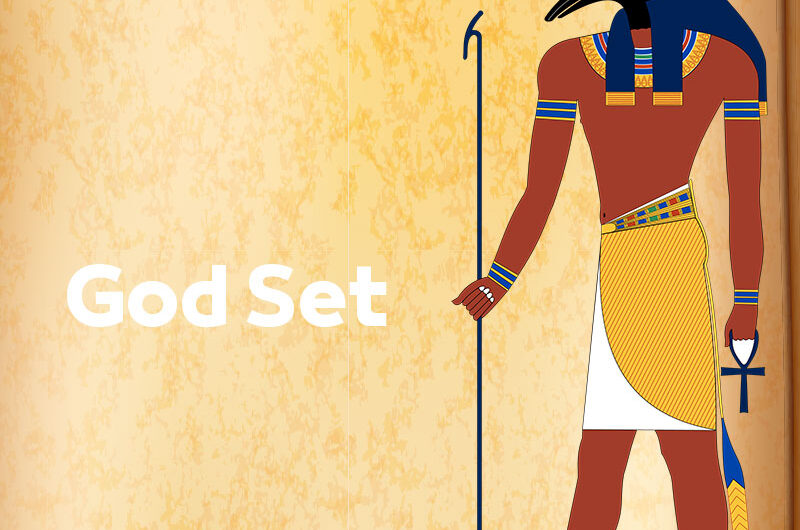God Set “Sutekh, Seth” | Facts The Egyptian Gods and Goddesses | God of desert, storms disorder, violence in Pharaonic Civilization & Most Important Ancient Egypt Deities, Mythology Symbols, Definition, Temple, Photo, Who was and more…
symbol of chaos, violence, war, desert and storms among the ancient Egyptians and Pharaohs | Facts and history of gods and religious beliefs in the civilization of ancient Egypt and more The Pharaonic legends.
The god Set, Seth, or Sweetakh are all names of the god Set found in ancient Pharaonic and Greek myths. It is a symbol of chaos, violence, war, desert and storms.
Myths imagine that the birth of Set came from the marriage of Geb (the earth) and Nut (the sky). This marriage resulted in five gods, one of whom was the traitorous god Set.
The legend of Set and his brother Osiris:
The God Osiris was the first king to rule Egypt, and he had an evil brother who was jealous of him, called the god Set. The god Set killed his brother, the god Osiris, and cut his body into parts and distributed them throughout the country.
When the god Isis learned of the death of her husband, Osiris, she searched for all the parts of his body, assembled them again, and brought him back. For life and the god Horus gave birth to him.
The god Isis raised her son, the God Horus, until he grew up and became powerful. He went to the Egyptian Temples complex to restore the kingdom of his father, the god Osiris. Wars broke out between him and the god Set, until he seized the throne and became king of Lower Egypt, then unified the country under his rule.
God Set
- The god Set is the twin brother of the goddess Nevis, whom he later married. He is also the brother of Isis and Osiris, who married and became the king and queen of Egypt.
- The hierarchical texts portray the danger of Set since his childhood. When he was an infant, he was not born naturally like the rest of his siblings, but violently pulled himself out of his mother’s womb.
- Despite his evil, he was not the main evil god in ancient religions. He was initially a righteous fighter, and he was an ally of the god Ra (the god of light), as he fought with him to repel the evil god (Aviv). He was also a friend of the dead, as he had a ladder to help them ascend to heaven.
- The worship of the god Set originated in the town (Kom Ombo) in Aswan, which was called (Nopet) in the pre-dynastic era.
- Over time Set began to enjoy a bad reputation and his worship as a deity ended because of his actions.
The supernatural powers that characterize
- Muscular Strength: God Set is the strongest of all the gods, he was able to lift up to 70 tons. But he lost his right hand, even if he is no longer able to do so.
- Endurance: God Set can endure strenuous muscular exertion for several days without getting tired, as his muscles produce fatigue toxins in much smaller quantities than normal humans. His body was resistant to physical injuries, and was not affected by temperature or pressure, yet he did not have the ability to regenerate limbs and organs.
- Super Speed: The god Set outruns any human at long distance running. He also had the ability to teleport himself over great distances.
- Eternal immortality: Like all the gods of Heliopolis, his body is always young and does not reach old age, and he does not suffer from any diseases or infections that afflict humans.
- Energy Manipulation: Set could burn anyone by directing a powerful beam of fire from his eyes, and he had the ability to direct the powerful energies of his body and cause death with a single touch.
- Shapeshifting: The god Set can change his shape, transforming himself into a giant snake
- Genius and Super Intelligence: Set’s mind has no rival in the universe.
- Skilled Fighter: Six is a good fighter even without using weapons, but since losing his hand, his greatest strength is in the energy field.
The story of the god Set and the goddess Isis and Osiris
- After Osiris became king of Egypt, Seth became jealous and began plotting to get rid of him and seize his throne.
- Set killed his brother Osiris and cut his body into 14 pieces and spread them all over Egypt, and then installed himself as king of the country.
- Isis was able to assemble Osiris’ body again, and revived his body for a short period of time that was enough to conceive Isis in their son, Horus.
- Isis hid to be able to raise her son, so Horus grows up and fights his uncle Set in a fierce war, which ended in an initial defeat for Set, but after that Horus also lost his eyes after Set gouged them out.
- In the end, neither side was victorious, so the god Thoth intervened to end this conflict, so he ruled that Horus would regain his father’s throne and rule Egypt, and a suitable funeral would be held for his father Osiris, and despite the injustice of the god Set, he was once again assigned to rule the desert and foreign lands.
History of the Nile River in the Osiris myth
One of the most popular stories in ancient Egypt about the Nile is that of the god Osiris and his betrayal and assassination by his brother god Set. Jealous of Osiris’ power and popularity, Set led him to lie down in an elaborate coffin (sarcophagus) and pretend to give it to whoever fit best. Once Osiris was inside, Set slammed the lid shut and threw Osiris into the Nile.
The wife of Osiris, Isis, went in search of her husband’s body to give it a proper burial and after looking in many places she came across some children playing by the Nile and told her where she could find the coffin. From this story comes the ancient Egyptian belief that children had the gift of divination because they could tell the goddess something she could not discover herself.
The coffin floated down the Nile until it landed in Byblos (in Phoenicia) in a tree that quickly grew around it, enclosing it. The king of Byblos admired the strong, powerful-looking tree and had it brought to his court and set up as a pillar.
When Isis arrived in Byblos in the course of her quest, she realized that her husband’s body was in the tree, and after endearing herself to the king, she asked for the pillar as a favour.
Isis then brought her dead husband back to Egypt to bring him back to life. This sequence of events inspired the Djed Pillar, a symbol that appears in Egyptian architecture and art throughout the country’s history, symbolizing stability. The Djed represents, according to some interpretations, the spine of Osiris when he was enclosed in the tree, or according to others, the tree itself from which Isis removed the body of Osiris in order to bring it back to life.
Back in Egypt, Isis left Osiris in his coffin by the Nile to prepare the herbs and potions to bring him back to life. She left her sister Nephthys to guard the corpse before Set. However, upon hearing that Isis had been looking for Osiris, Set went looking for the corpse himself. He encountered Nepthys and forced her to tell him where his brother’s body was hidden.
When he found it, he chopped up the corpse and scattered it throughout Egypt. When Isis returned to revive her husband, Nepthys tearfully confessed what had happened and vowed to help her sister find out what Set had done to Osiris’ body.
This explains the many tombs of Osiris throughout ancient Egypt, and is also believed to have established the nomen, the thirty-six territorial subdivisions of ancient Egypt (similar to a county or province). Wherever part of Osiris was buried, a gnome eventually grew up.
She managed to find and bury every part of him except his penis, which Set had thrown into the Nile and which was eaten by a crocodile. Because of this, the crocodile was associated with the fertility god Sobek, and anyone who was fed by a crocodile being eaten was considered a happy death.
Being incomplete, Osiris could not return to life, but instead became lord of the afterlife and judge of the dead. The Nile, which had received Osiris’ penis, was thereby made fertile and gave life to the people of the land. Osiris’ son Horus avenged his father by defeating Set and driving him out of the country (killing him in some versions of the story), thus restoring balance and order to the region. Horus and Isis then ruled the land in harmony.
Isis and Nepthys went in search of the remains of Osiris and wherever they found a piece of him, they buried it according to the proper rituals and built a shrine.
Hurghada Lovers best Tour Operator to provide daily tours to visit the Tourist attractions of Luxor by Hurghada to Luxor Day Trips and Cairo by Hurghada to Pyramids Day Trips to discover the secrets. Book online when you come to Hurghada, El Gouna, Sahl Hashish, Makadi Bay, Soma Bay.

